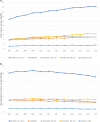Distinct prognosis of biliary tract cancer according to tumor location, stage, and treatment: a population-based study
- PMID: 35715440
- PMCID: PMC9205970
- DOI: 10.1038/s41598-022-13605-3
Distinct prognosis of biliary tract cancer according to tumor location, stage, and treatment: a population-based study
Abstract
Biliary tract cancer (BTC) has been inconsistently identified according to its location in epidemiological and clinical studies. This study retrospectively reviewed the treatment pattern and prognosis of BTC according to tumor location using the Korea Central Cancer Registry data of 97,676 patients with BTC from 2006 to 2017. The proportion of localized and regional Surveillance, Epidemiology, and End Results (SEER) stage was the highest in ampulla of Vater (AoV, 78.2%) cancer, followed by extrahepatic bile duct (BD, 68.3%), gallbladder (GB, 52.6%), and intrahepatic BD (49.5%) cancers. Overall, the "no active anti-cancer treatment" rate was the highest in intrahepatic BD (52.8%), followed by extrahepatic BD (49.5%), GB (39.6%), and AoV cancers (28.9%). The 5-year relative survival rate was the highest in AoV (48.5%), followed by GB (28.5%), extrahepatic BD (19.9%), and intrahepatic BD (10.8%) cancers, which significantly improved over time, except for intrahepatic BD cancer. In the localized and regional stage, older patients had a higher risk of receiving no active anti-cancer treatment in each tumor location after adjusting for period and sex. BTC statistics should be reported separately according to tumor location due to its distinct SEER stage distribution, treatment pattern, and prognosis. Care should be taken in elderly patients to reduce the rate of no active anti-cancer treatment.
© 2022. The Author(s).
Conflict of interest statement
The authors declare no competing interests.
Figures




References
-
- The Global Cancer Observatory. Cancer today; Gallbladder (C23). https://gco.iarc.fr/today/data/factsheets/cancers/12-Gallbladder-fact-sh... (2020). Accessed 10 September 2021.
Publication types
MeSH terms
LinkOut - more resources
Full Text Sources
Medical

